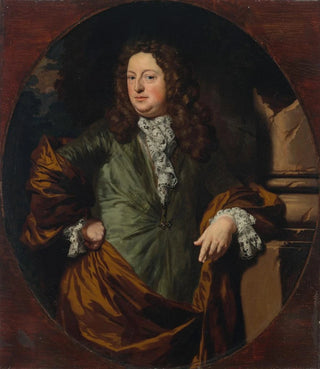Taidetuloste | Portrait of a man traditionally identified as the Count Borchgrave - Nicolaes Maes


Takaa näkyvä näkymä

Kehys (valinnainen)
Reproduction Portrait of a man traditionally identified as the Count Borchgrave - Nicolaes Maes – Engaging introduction
« Reproduction Portrait of a man traditionally identified as the Count Borchgrave » by Nicolaes Maes is an iconic work that embodies the very essence of 17th-century Dutch portraiture. This painting, both realistic and psychologically profound, immerses us in a universe where technical mastery meets a keen sensitivity to human representation. By contemplating this work, the viewer is inevitably drawn to the penetrating gaze of the subject, which seems to tell a personal story while evoking the sociopolitical concerns of its time. The light, skillfully orchestrated, highlights the delicate features of the face and the textures of the clothing, giving the entire piece an atmosphere that is both intimate and majestic.
Style and uniqueness of the work
The uniqueness of this work lies in how Maes manages to capture not only the physical appearance of his model but also their inner essence. The chosen color palette, subtle and nuanced, suggests a richness that goes beyond mere ornamentation. Shadows and lights intertwine harmoniously, creating a three-dimensional effect that brings the canvas to life. The realism of the depiction is enhanced by the attention to detail, whether in the folds of the clothing or in the facial expression. Each element seems designed to engage the viewer, inviting prolonged contemplation. Thus, Maes is not just a talented portraitist; he becomes a visual storyteller, capable of transcending time and space.
The artist and his influence
Nicolaes Maes, born in Dordrecht in 1634, is an artist whose impact on Dutch painting is undeniable. A pupil of Rembrandt, he mastered his master's lessons while developing a personal style. His career, which began with religious works and genre scenes, gradually evolved towards portraiture, a field in which he excels. Maes was able to capture the spirit of the times, reflecting the values and concerns of 17th-century Dutch society through his works. His influence is felt not only in…

Rendu mat

Takaa näkyvä näkymä

Kehys (valinnainen)
Reproduction Portrait of a man traditionally identified as the Count Borchgrave - Nicolaes Maes – Engaging introduction
« Reproduction Portrait of a man traditionally identified as the Count Borchgrave » by Nicolaes Maes is an iconic work that embodies the very essence of 17th-century Dutch portraiture. This painting, both realistic and psychologically profound, immerses us in a universe where technical mastery meets a keen sensitivity to human representation. By contemplating this work, the viewer is inevitably drawn to the penetrating gaze of the subject, which seems to tell a personal story while evoking the sociopolitical concerns of its time. The light, skillfully orchestrated, highlights the delicate features of the face and the textures of the clothing, giving the entire piece an atmosphere that is both intimate and majestic.
Style and uniqueness of the work
The uniqueness of this work lies in how Maes manages to capture not only the physical appearance of his model but also their inner essence. The chosen color palette, subtle and nuanced, suggests a richness that goes beyond mere ornamentation. Shadows and lights intertwine harmoniously, creating a three-dimensional effect that brings the canvas to life. The realism of the depiction is enhanced by the attention to detail, whether in the folds of the clothing or in the facial expression. Each element seems designed to engage the viewer, inviting prolonged contemplation. Thus, Maes is not just a talented portraitist; he becomes a visual storyteller, capable of transcending time and space.
The artist and his influence
Nicolaes Maes, born in Dordrecht in 1634, is an artist whose impact on Dutch painting is undeniable. A pupil of Rembrandt, he mastered his master's lessons while developing a personal style. His career, which began with religious works and genre scenes, gradually evolved towards portraiture, a field in which he excels. Maes was able to capture the spirit of the times, reflecting the values and concerns of 17th-century Dutch society through his works. His influence is felt not only in…






